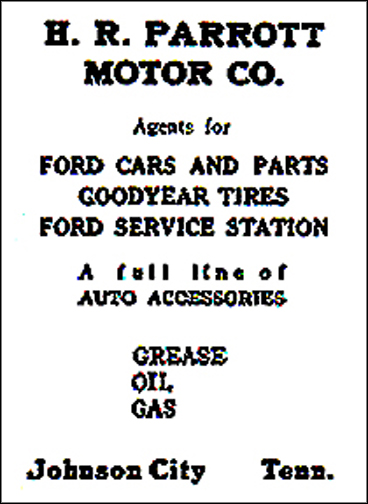The late Tom Hodge once wrote a highly informative column about the early Ford dealerships in Johnson City. Five local individuals shared their remembrances with him. Henry Row, the initial responder, said that he worked for H.R. Parrott Motors in 1916 and 1917, recalling that Parrott had also been a partner in Summers-Parrott Hardware, a forerunner to Summers Hardware.

The dealership was located on Ash Street along the southwest end of the block. Henry said the late Harry Range had once been a partner in the dealership and believed the firm was sold about 1920. Row was hired by the business to assemble T Model Fords that came to Johnson City packed six to a railcar, the frames being crisscrossed along one end and the bodies at the other. The autoworker’s task was to install the wheels, position the bodies on the frames, move them into the shop and bolt everything tightly together. One auto took approximately a day to fully assemble.
Henry laughingly commented that when he entered the Army in 1917, he ended up in France … assembling Model T Fords. The Army found much use for this unique vehicle. Row said the Model T sold for roughly $350, becoming a much sought after and profitable seller for the company.
Lee Wallace next contacted Tom to say that James A. Summers and H.R. Parrott were jointly involved in the hardware and car dealership businesses in 1911. In 1914, each entrepreneur swapped his half interest, giving Summers sole ownership of the hardware and Parrott the auto business. Lee remembered when Summers Hardware was involved in construction work at the site and uncovered parts of old Fords buried in the former driveover pit.
Gardner Range, whose father once worked for Parrott Motor Company, supplied Tom with additional facts. Gardner once had a list of prices for the Model T. He recalled that the car had a base price and many items considered standard today were priced separately as extras. There were many Model T cars roaming the countryside without bumpers. Before someone could acquire a Ford dealership, he had to agree to also carry the Ford tractor, known as a Fordson. Range recalled that his father purchased an outdoorsman outfit and wore it while demonstrating tractors to prospective buyers.
Another individual, Jim Stewart, contacted Hodge to say that when he was a little boy in western Pennsylvania, the Fordson tractors were fairly new and very popular with area farmers. Jim related that the tractors had tanks containing two different fuels. Gasoline was used to start the engine and run it until the engine became hot. The driver then switched to kerosene as its primary fuel.
Finally, Lewis Holley shared with Hodge the fact that the Grove Inn was located just down the road from the dealership near the old Clinchfield Railroad Depot. The facility, operated by a Potter family, was a boarding house that catered to railroad passengers. It had a swinging bridge across the creek.
Around 1925, Universal Motor Corporation opened along the southeast side of the intersection of King and Boone streets, selling the Ford, Lincoln and Fordson. In my next column, I will continue the Ford theme by sharing some interesting memories of Geneva Feathers who worked at Tennessee Motors in the 1940s.
